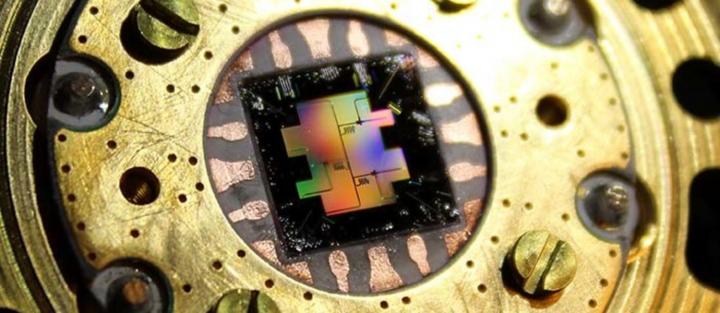New physics rules tested on quantum computer

A quantum circuit
Credit: Aalto University
Simulation of non-Hermitian quantum mechanics using a quantum computer goes beyond centuries old conventions.
Aalto researchers have used an IBM quantum computer to explore an overlooked area of physics, and have challenged 100 year old cherished notions about information at the quantum level.
The rules of quantum physics – which govern how very small things behave – use mathematical operators called Hermitian Hamiltonians. Hermitian operators have underpinned quantum physics for nearly 100 years but recently, theorists have realized that it is possible to extend its fundamental equations to making use of Hermitian operators that are not Hermitian.
The new equations describe a universe with its own peculiar set of rules: for example, by looking in the mirror and reversing the direction of time you should see the same version of you as in the actual world. In their new paper, a team of researchers led by Docent Sorin Paraoanu used a quantum computer to create a toy-universe that behaves according to these new rules. The team includes Dr. Shruti Dogra from Aalto University, first author of the paper, and Artem Melnikov, from MIPT and Terra Quantum.
The researchers made qubits, the part of the quantum computer that carries out calculations, behave according to the new rules of non-Hermitian quantum mechanics. They demonstrated experimentally a couple of exciting results which are forbidden by regular Hermitian quantum mechanics. The first discovery was that applying operations to the qubits did not conserve quantum information – a behaviour so fundamental to standard quantum theory that it results in currently unsolved problems like Stephen Hawking’s Black Hole Information paradox. The second exciting result came when they experimented with two entangled qubits.
Entanglement is a type of correlations that appears between qubits, as if they would experience a magic connection that makes them behave in sync with eachoter. Einstein was famously very uncomfortable with this concept, referring to it as “spooky action at a distance”. Under regular quantum physics, it is not possible to alter the degree of entanglement between two particles by tampering with one of the particles on its own. However in non-Hermitian quantum mechanics, the researchers were able to alter the level of entanglement of the qubits by manipulating just one of them: a result that is expressly off-limits in regular quantum physics.
“The exciting thing about these results is that quantum computers are now developed enough to start using them for testing unconventional ideas that have been only mathematical so far” said Sorin Paraoanu. “With the present work, Einstein’s spooky action at a distance becomes even spookier. And, although we understand very well what is going on, it still gives you the shivers.”
The research also has potential applications. Several novel optical or microwave-based devices developed in recent times do seem to behave according to the new rules. The present work opens the way to simulating these devices on quantum computers.
###
The paper “Quantum simulation of parity-time symmetry breaking with a superconducting quantum processor” is published in Communications Physics. The work was performed under the Finnish Center of Excellence in Quantum Technology (QTF) of the Academy of FInland. You can read the full article here [https:/
All latest news from the category: Physics and Astronomy
This area deals with the fundamental laws and building blocks of nature and how they interact, the properties and the behavior of matter, and research into space and time and their structures.
innovations-report provides in-depth reports and articles on subjects such as astrophysics, laser technologies, nuclear, quantum, particle and solid-state physics, nanotechnologies, planetary research and findings (Mars, Venus) and developments related to the Hubble Telescope.
Newest articles

Innovative 3D printed scaffolds offer new hope for bone healing
Researchers at the Institute for Bioengineering of Catalonia have developed novel 3D printed PLA-CaP scaffolds that promote blood vessel formation, ensuring better healing and regeneration of bone tissue. Bone is…

The surprising role of gut infection in Alzheimer’s disease
ASU- and Banner Alzheimer’s Institute-led study implicates link between a common virus and the disease, which travels from the gut to the brain and may be a target for antiviral…

Molecular gardening: New enzymes discovered for protein modification pruning
How deubiquitinases USP53 and USP54 cleave long polyubiquitin chains and how the former is linked to liver disease in children. Deubiquitinases (DUBs) are enzymes used by cells to trim protein…


